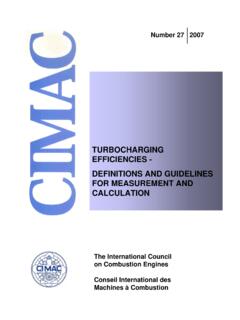Transcription of 01 | 2019 - CIMAC
1 01 | 2019 . CIMAC Guideline Marine fuel handling in connection to stability and compatibility By CIMAC WG7 Fuels This publication is for guidance and gives an overview regarding the assessment of marine fuel stability and compatibility and how to mitigate the associated risk. The publication and its contents have been provided for informational purposes only. CIMAC makes no representations or warranties express or implied, regarding the accuracy, adequacy, reasonableness or completeness of the information, assumptions or analysis contained herein or in any supplemental materials, and CIMAC accepts no liability in connection therewith. The first edition of this CIMAC Guideline was approved by the members of the CIMAC WG7 Fuels' in November 2019 . Content 1 Scope.
2 3. 2 Introduction .. 3. Stability in the context of IMO 2020 .. 3. 3 PART 1 Understanding Stability and 4. The complexity of residual fuel oils .. 4. Stability .. 4. Factors influencing stability .. 5. Compatibility .. 5. Stability Reserve .. 5. Consequences of unstable fuel .. 5. Practical steps mitigating the risk of a fuel becoming unstable on board .. 6. 4 PART 2 Test methods explained .. 8. 8. Test methods for evaluating stability and 8. Sediment methods .. 9. ISO 10307-1 (Existent Total Sediment, TSE) .. 9. ISO 10307-2 (Potential Total Sediment, TSP - Procedure A) .. 9. ISO 10307-2 (Accelerated Total Sediment, TSA - Procedure B) .. 9. ASTM D4740 (Cleanliness / compatibility) .. 9. Limitation of the spot test 10. ASTM D7157, ASTM D7112 and ASTM D7060.
3 11. Terms .. 11. ASTM D7157 .. 12. ASTM D7112 .. 12. ASTM D7060 .. 12. Compatibility model: ASTM D7157 and ASTM 12. Compatibility model: ASTM 14. 5 Summary / Conclusions .. 16. 6 Members of CIMAC WG7 17. 7 References .. 18. 8 Glossary of important, repeating terms .. 18. 9 Annex A .. 19. What can influence stability - the chemistry explanation .. 19. Asphaltene stability .. 20. 10 Annex B ASTM D4740 Reference Spot test' 21. CIMAC Guideline Marine fuel handling in connection to stability and compatibility , 2019 -01 (1st edition) Page 2. 1 Scope This guidance aims to provide a practical and working understanding of the definition of stability and compatibility of marine fuel oils and how these two specific fuel properties may be best managed in the supply chain and on-board ships.
4 This compliments and expands on the information given in ISO/PAS 23263: 2019 Considerations for fuel suppliers and users regarding marine fuel quality in view of the implementation of maximum Sulphur in 2020 (hereafter referred to as the PAS ). The PAS has been written to support the International marine fuel standard ISO 8217:2017, to which this guideline will also refer. Details on the accepted available test methodologies for stability and for predicting compatibility are included, covering their applicability and correct interpretation. All stakeholders involved, in the supply and/or use of marine fuel oil are invited to adopt this guidance as 'the common industry approach' on the subject matter. 2 Introduction Essentially all existing marine fuels, distillates and residuals, are to some degree mixtures or blends of a range of hydrocarbon fractions both in terms of the base hydrocarbon products from which they have been produced and from subsequent blending, to meet certain specification requirements.
5 Already a factor of existing fuels, marine fuel stability is addressed in ISO 8217:2017 by test method ISO 10307-2. It is the responsibility of the supplier to ensure that the fuel as delivered is stable. It is the responsibility of the engineers on board to apply best practice fuel management to mitigate the risk of mixing incompatible fuels; this is best achieved through defining a ship specific storage segregation strategy and where this cannot be avoided by applying a concise commingling plan. Various methods are available for determining the compatible nature of a specific fuel with other fuels. This document provides an overview of the commonly accepted and available test methods applicable to fuel stability. In addition, the methods that can be used to evaluate compatibility between fuels, either by direct testing and/or through forward prediction will be covered.
6 Stability in the context of IMO 2020. Traditionally, for the residual fuels, blending was principally in terms of viscosity control but then, with the greater availability of high -density refinery products, density also became a blending factor. The increasing restrictions on marine fuel sulphur content, defined by MARPOL Annex VI. Regulation , have changed the primary blend target from viscosity and density to sulphur. Whereas viscosity and/or density are at a relatively consistent level within the same fuel grades in the pre-2020 fuels, the implications of this mean that marine fuels post 2020 are expected to result in a wide variability of fuel formulations and characteristics alike. CIMAC Guideline Marine fuel handling in connection to stability and compatibility , 2019 -01 (1st edition) Page 3.
7 Despite this variability in characteristics against a single ordering specification, CIMAC still recommends all marine fuels be purchased under ISO 8217:2017 1 in its entirety 2. In addition, the fuels shall be sulphur compliant in accordance to statutory requirements. 3 PART 1 Understanding Stability and Compatibility The complexity of residual fuel oils It is important to appreciate that residual marine fuel's chemical composition is difficult to define as it much depends upon the source of the crude oil and the manufacturing processes. The constituents of a residual fuel however include asphaltenes, resins and liquid hydrocarbons. The generic term asphaltenes' covers a wide range of heavier hydrocarbon structures of high molecular weight and high carbon/hydrogen ratios, the exact constituents being dependent on the crude source and choice of blend stocks.
8 The nature of the liquid hydrocarbons will determine the fuels capability to maintain the asphaltenes in suspension and remain in a stable condition allowing this important source of energy to take part in the combustion process. (See Annex A for a more detailed chemical explanation). If the asphaltenes cannot be retained in their suspended (colloidal) state, they will drop out as sludge and the fuel has become unstable. Any break in the suspension results in an irreversible unstable condition, with potential serious operational implications, the likes of which are explained later in this document. The terminology used when talking about the risk of asphaltenes precipitation is: Stability: The fuel as supplied Compatibility: The ability of two fuels forming a stable mix when commingled Stability Reserve: A measure of the ability of an oil to maintain asphaltenes in a dispersed state and prevent flocculation of the asphaltenes Stability Since asphaltene-free fuels cannot precipitate asphaltenic sludge by themselves, it is not applicable to discuss asphaltene stability for such fuels.
9 The stability of a residual fuel is defined by its resistance to precipitate asphaltenic sludge despite being subjected to forces, such as thermal and ageing stresses, while handled and stored under normal operating conditions. ISO 8217:2017 specifies that fuels must be stable. 1 This guideline can also be used in conjunction with earlier editions of ISO 8217 when an earlier edition is included in the commercial agreement between seller and buyer 2 See also ISO/PAS 23263: 2019 . CIMAC Guideline Marine fuel handling in connection to stability and compatibility , 2019 -01 (1st edition) Page 4. Factors influencing stability Fuel formulation The first influence is in the formulation of the fuel blend itself. It is the responsibility of the supplier to formulate the blend to ensure that the fuel is stable and that the fuel's stability reserve is sufficient (see ) to withstand the anticipated influences and conditions on board ship.
10 Thermal and mechanical stresses The main influences on board ship are the direct thermal and mechanical stresses likely to be faced during storage, handling and through centrifugal treatment. Storage time Extended storage time can degrade the fuel to eventually break up, become unstable and deposit asphaltenic sludge. Since there is no definitive way of assessing how long a fuel will remain homogenous and stable during storage, handling or treatment on board, it is recommended to apply first-in first-out . principle on the use of fuel batches (see CIMAC Recommendation 25). Prior CIMAC advice has suggested to use fuels within 6 months, however, with the introduction of VLSFOs this period might need to be reduced. Compatibility Compatibility is the term used for the ability of two or more fuels to be comingled without evidence of material separation; or in other words, no asphaltenes precipitating when the fuels are mixed.






